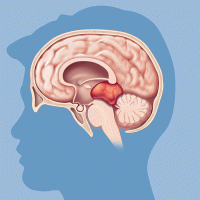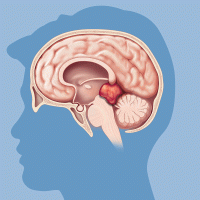Germ cell tumors are not usually managed with the traditional surgical goal of tumor removal, since all forms of germ cell tumors are highly responsive to radiation and chemotherapy. The role of surgery for patients with primary CNS GCT is highly nuanced and pivotal. The neurosurgical objectives include hydrocephalus treatment, CSF sampling, tumor biopsy, second-look surgery, and treatment of growing teratoma syndrome.
CSF Diversion
Preferred treatment for patients with pineal region tumors and obstructive hydrocephalus is endoscopic third ventriculostomy (ETV) with or without tumor biopsy. In the event that an ETV is deemed unsuitable, externalized ventricular drainage is an acceptable alternative. Implantation of a ventriculoperitoneal shunt (VPS) can be avoided in most cases. For large mass lesions in the parasellar compartment causing compartmentalized hydrocephalus, simultaneous VPS with endoscopic septal fenestration is favored.
Tumor Sampling
A suspicion of intracranial germ cell tumor seldom warrants aggressive upfront aggressive surgery. Serum and CSF biochemical analysis (human chorionic gonadotropin (HCG) and α fetoprotein (AFP)) should always precede decisions related to surgical sampling. Only biochemically silent tumors should be biopsied, with a preference for endoscopic techniques. Patients with either parasellar or pineal region tumors are candidates for a minimally invasive endoscopic biopsy procedure even if they have normal sized ventricles. Traditional surgical procedures such as craniotomy should be avoided if the objective is to perform a biopsy.
CSF Sampling
Simultaneous CSF sampling should accompany any form of CSF diversion. When endoscopic third ventriculostomy or placement of an externalized drain is needed for the treatment of hydrocephalus, CSF is readily collected and tested for tumor markers. In the absence of the hydrocephalus and deemed safe, lumbar puncture is advised. CSF samples should be assayed for tumor markers and cytopathology.

A non-germinomatous germ cell tumor that leaves residual disease after chemotherapy calls for second-look surgery
Second-Look Surgery
Most non-germinomatous germ cell tumors (NGGCT) will demonstrate response to neo-adjuvant chemotherapy. Complete biochemical response with residual disease on imaging after the first four to six cycles of chemotherapy warrants consideration for second-look surgery. These lesions are frequently consistent with tumor components that are not responsive to radiation or chemotherapy (mature or immature teratoma tumors) or treatment response. The intent of second-look surgery is usually a safe maximal resection.

Growing teratoma syndrome is characterized by honeycomb or bubbly-appearing tumors. They are unresponsive to radiation or chemotherapy and warrant a craniotomy for surgical excision
Growing Teratoma Syndrome
When tumor progression occurs during initial or induction chemotherapy, this usually represents an entity referred to as a growing teratoma syndrome (see animation at right). These honeycomb or bubbly-appearing tumors warrant a craniotomy for surgical excision given their known unresponsive nature to radiation or chemotherapy.
It is critically important for anyone with a known or suspected germ cell tumor in the brain to be treated by an interdisciplinary team at a major academic medical center. Germ cell tumors require the coordinated efforts of neuro-oncologists, neurosurgeons, pathologists, radiation oncologists, and other specialists to ensure the best outcome possible.
The team at the Weill Cornell Medicine Brain and Spine Center includes world-renowned experts in the treatment of germ cell tumors in the brain. Dr. Mark Souweidane, director of pediatric neurosurgery and vice chair of neurosurgery, has authored several academic papers about his experience and findings on these tumors, including a recent paper from the Children’s Oncology Group. He also serves as the neurosurgery study section representative for the current cooperative group's clinical trials. To request an appointment (in person or by video visit), please use this online appointment request form or call 212-746-2363.
Reviewed by Mark M. Souweidane, MD
Last reviewed/last updated: December 2020